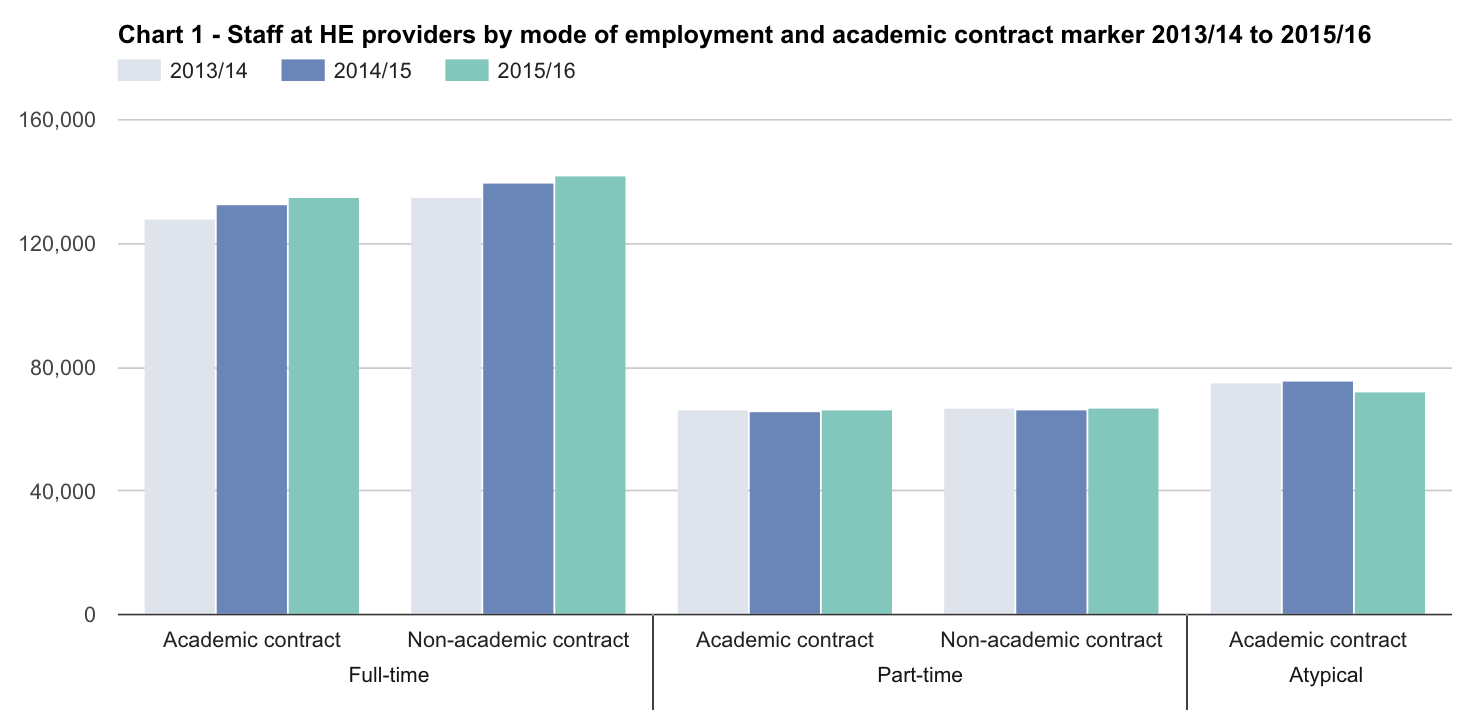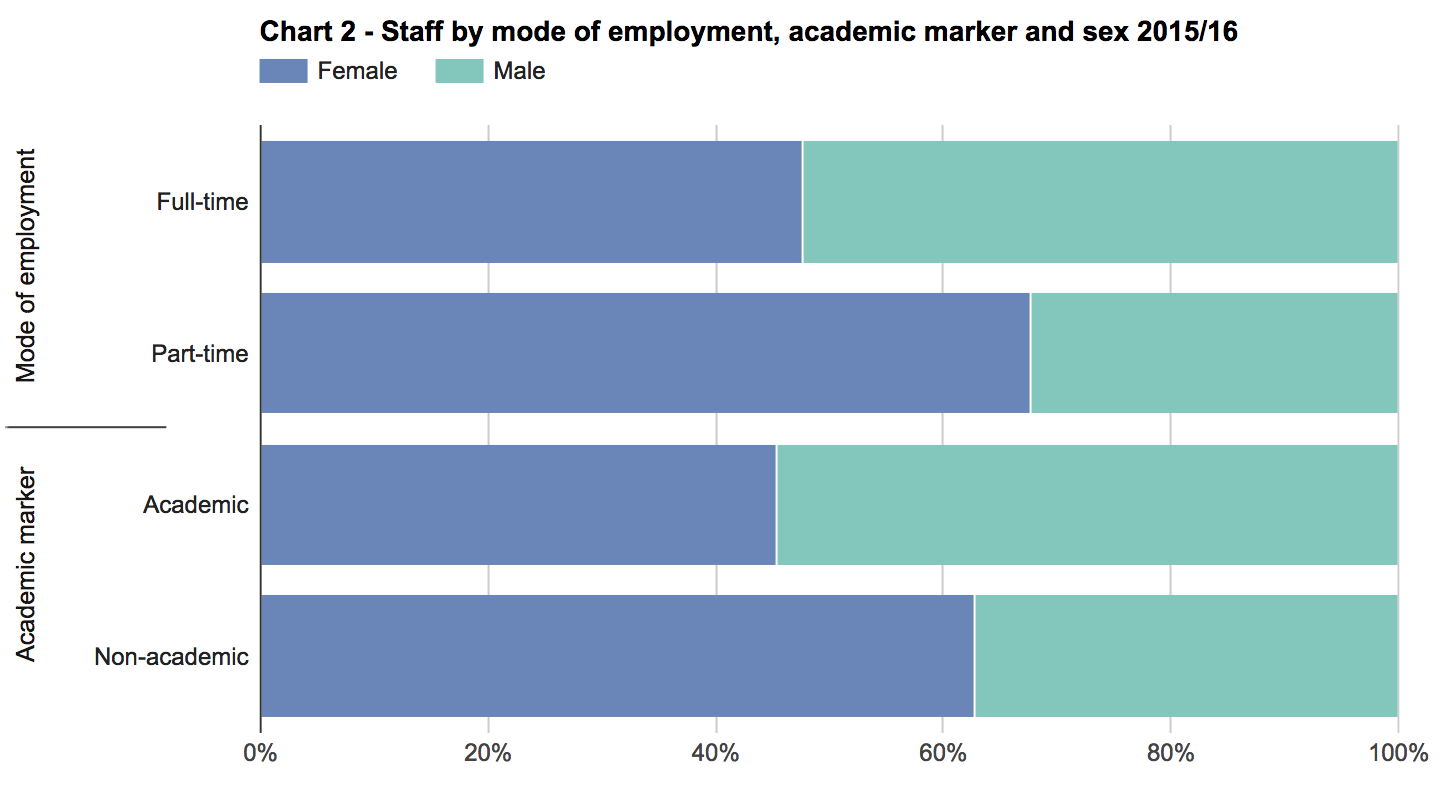Staff at higher education providers in the United Kingdom 2015/16
This SFR includes: Introduction | Key points | Tables | Definitions | View a printable version of this SFR
Introduction
Our Statistical First Release contains interactive charts which require Javascript to be enabled. Without Javascript, we present static charts below.
This is the first release of data from the 2015/16 HESA Staff record. The release provides details of staff employment at UK higher education providers on 1 December 2015. It has been produced in partnership with the UK administrations and is released in accordance with the arrangements approved by the UK Statistics Authority.
New to the Statistical First Release this year is an additional table on person characteristics of all staff Table 3. Detailed analysis of the HESA Staff record will be available in the reference volume Staff in Higher Education 2015/16 due to be released in February 2017.
Key points - all staff
On 1 December 2015 there were 410,130 staff (excluding atypical staff, refer to definitions below) employed in the HE sector, showing an increase of 2% from 403,835 staff employed on 1 December 2014. 49% of staff were employed on academic contracts in 2015/16, the same percentage as in 2014/15. This corresponds to 201,380 staff in 2015/16 and 198,335 in 2014/15. The majority of these were in professional occupations (refer to the definitions for further detail of occupational classifications). Chart 1 shows the numbers of staff by contract type and mode over the last 3 years.

In 2015/16, for the first time, atypical staff on non-academic contracts were excluded from the coverage of the Staff record. Prior to this, HE providers could optionally return this information.
277,055 staff were employed on full-time contracts, an increase of 2% from 272,250 in 2014/15 and 133,070 on part-time contracts, an increase of 1% from 131,585 in 2014/15.
Over the 2015/16 academic year, 72,015 atypical staff were employed by HE providers on academic contracts, a decrease of 5% from 2014/15. Atypical staff include individuals employed for one-off/short-term tasks and those employed for less than four consecutive weeks. As such, the total full-time equivalent (FTE) value of atypical staff in 2015/16 was only 4,850 (note: further detail on Staff FTE will be published in February 2017 in Staff in Higher Education 2015/16).
48% of full-time staff and 68% of part-time staff were female in 2015/16.
Key points - academic staff
Of the 201,380 academic staff on 1 December 2015, 91,150, or 45%, were female, the same proportion as in 2014/15.
49%, or 98,620, of academic staff on 1 December 2015 were employed on contracts described as having a teaching and research function. 26%, or 52,590, had an academic employment function described as teaching only.
19,975 academic staff were employed on a contract level described as a professor in 2015/16 (it should be noted that this is likely to be an undercount of all professors because many will fall into more senior levels, i.e. Heads of Department, refer to definitions). 4,775 of these staff were female representing 24%. A further 6,160 academic staff were employed on Other senior academic contracts, 2,155 were female representing 35%.
66%, or 132,070, of academic staff were employed on open-ended or permanent contracts in 2015/16 and 34% were employed on fixed term contracts.
Of those academic staff with known nationality, 17%, or 33,735, had an EU (excluding the UK) nationality, and 12% had a non-EU nationality.
19% of all academic staff were aged 56 and over.
Key points - non-academic staff
Of the 208,750 non-academic staff on 1 December 2015, 16% were aged 56 and over, while just 9% were 25 and under. These percentages differed by occupation type, with sales and customer service occupations seeing the highest percentage of staff aged 25 and under, at 23%, and process, plant and machine operatives seeing the highest percentage of staff aged 56 and over, at 31%.
5% of non-academic staff were known to have a disability, and 11%, or 21,280, were BME (Black and Minority Ethnic).
63%, or 130,855, of non-academic staff were female, and of those non-academic staff with known nationality, 6%, or 12,490, had an EU (excluding the UK) nationality. Just 4% had a non-EU nationality, much lower than the proportion among academic staff.
Tables
Definitions
The data in this SFR is based on the 2013/14 to 2015/16 HESA Staff record. The statistics in this SFR are derived by HESA from data collected from all publicly funded higher education providers in the UK, plus the University of Buckingham, which is a non-publicly-funded HE provider.
Data was prepared in December 2016 using the following versions of the datasets:
- 2013/14 Fixed dataset, November 2015 version
- 2014/15 Original dataset, November 2015 version
- 2015/16 Original dataset, November 2016 version.
Staff definitions
- Coverage
- Fixed database
- Full-person equivalent (FPE)
- Rounding strategy
- Academic employment function
- Academic employment marker
- Age
- Atypical staff
- Disability status
- Ethnicity
- Mode of employment
- Nationality
- Professorial status
- Sex
- SOC - Occupational coding for higher education staff
- Source of basic salary
- Terms of employment
For data intelligence, please see the following web page.
HESA cannot accept responsibility for any inferences or conclusions derived from the data by third parties.
Press enquiries should be directed to the Press Office at HESA, 95 Promenade, Cheltenham, GL50 1HZ, +44 (0)1242 211120, [email protected]. General enquiries about the data contained within this SFR should be addressed to Rebecca Haslam, Senior Information Analyst, HESA (at the same address), +44 (0)1242 211133, [email protected].
Feedback
This year we've redesigned how we present information in our Staff SFR. We’ve also included a new table on person characteristics (Table 3). We would like to hear your feedback, which can be sent to Rebecca Haslam, [email protected].
Ends
Embargo
19 January 2017, 9:30
Coverage
UK
Themes
Children, education and skills
Issued by
HESA, 95 Promenade, Cheltenham, GL50 1HZ
Press enquiries
01242 211120
Public enquiries
01242 211133
Statistician
Rebecca Haslam

 Academic marker Mode of employment
Academic marker Mode of employment